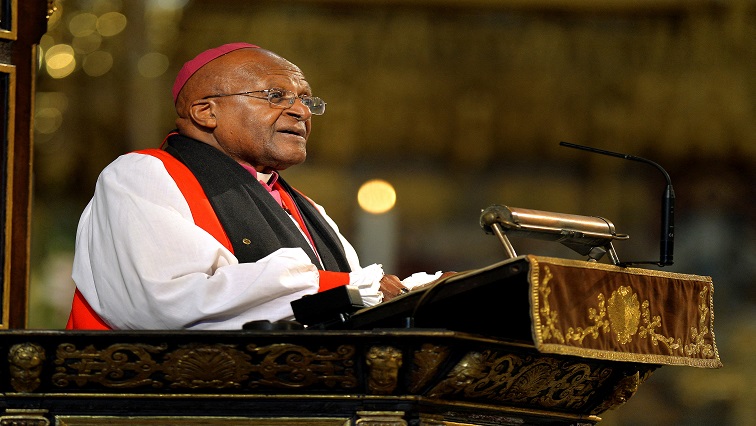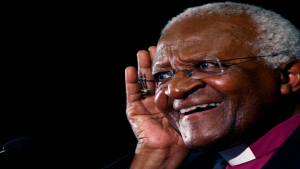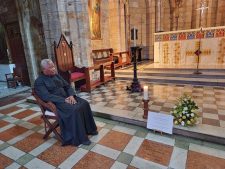The Cathedral Church of Saint Mary the Virgin, located in Johannesburg CBD, is also home to the late Archbishop Emeritus Desmond Tutu.
In 1975, Tutu became the first black person to be appointed as the Dean of the church.
The sense of peace and tranquility, and the fantastic views one gets of the high alters as you walk in the west doors, you are immediately aware that this is a place of God.
Person after person will tell that when they come in here, they feel God’s presence. Somehow this building has something about it which conveys that message.
St Mary’s – which was then, one of the few racially-integrated churches in the city that is the pulse of South Africa – is best known for its strong ties to the struggle against apartheid.
More significantly, the cathedral is remembered as the church that built Tutu as a respected priest – whose sermons reflected the lived-experience of the majority of South Africans seeking comfort from oppression.
In 1975, a young Desmond Tutu was appointed dean of St Mary’s the Virgin – becoming the first black person to hold the position.
The current dean recalls the impact of Tutu’s arrival at the church – and believes his leadership came at a very critical time.
Anglican Church’s dean for Johannesburg Diocese, Reverend Xolani Dlwati says, “There were two responses on his appointment as dean. Those who [supported him] were of course happy, delighted and excited about a black dean in the Anglican Cathedral of Johannesburg. Because if you remember, this Cathedral is one of the biggest in Africa. So Johannesburg is the engine of Africa. So to have a black dean at that time was quite a miracle.”
This cleric – who was at St Mary’s at the time – recalls how Tutu’s appointment as the church’s first black dean was not welcomed by all in the Anglican Church.
Reverend Margaret Place says, “I joined the church after Tutu who was the first black man at the Cathedral. It was my introduction to Anglicanism, and to South African politics, as it really is because the Cathedral was always very real about issues of injustice of this country.”
“Bishop Tutu is not known as a political figure. But what people don’t know is that he was a superb theologist and a wonderful preacher and a very pastoral person.”
Some believed that this house of the Lord was not a place to preach about the country’s political situation.
But for most, his sermons were a reminder of equality of all – irrespective of colour.
St Mary’s Reverend Peter Place says, “The involvement of Tutu here at the St Mary’s Cathedral as dean was to get the white South Africans to get closer to black South Africans, which, those days was incredible to do because the Cathedral being multiracial since 1960’s. So on that point onwards, it became one of the few multiracial congregations and it was a place where I could meet South Africans from all walks of life.”
“That, for me, was incredibly valuable because we were not living in silos within this congregation. it was a privilege to work with them, along them and not for them. The leadership of the Cathedral during those days, the bishop being TB and the dean being arch Desmond Tutu that was a powerful combination of people.”
Long-time congregant, John Malima says, “He really gave us wonderful sermons that uplifted us. He would take politics to church and they were church related. During that time we were worshipping with white people and many of them left the church and went to the northern suburbs church because of the political message Tutu was preaching. But he was very brave, he had no fears whatsoever.”
Rich history
St Mary’s was completed back in 1929; its builders could imagine that more than 100 years later, their beautiful Cathedral would be famous for its rich history.
On his return after 30 years in exile, OR Tambo chose to worship at this church where his wife, Adelaide Tambo, was a church elder who received the Anglican Church’s highest honour.
Following his death, the iconic African National Congress (ANC) president would leave here for his burial in Benoni.
The apartheid regime and its sympathisers, felt politics and the church should be separated and did whatever they could to push their agenda.
But most African priests believed that they are the shepherds of a flock that was marginalised, troubled and harassed by an evil system.
Methodist Church Priest Zinzi says, “He gave an example of really what a Christian church should be. Jesus came to save all people in all senses and that doesn’t only mean your salvation, it also means liberation [and] justice. [It] means for the poor to live and become the human beings they were supposed to be. I think in life, in all its fullness is what you feel when you have Bishop Tutu and his lovely sense of humour.”
After a year, Tutu left his post here to become the bishop of the Lesotho.
Today, over four decades later, the Cathedral of St Mary’s the Virgin remains a place of safety, a centre of hope and democratic activity.
The video below is reporting that Cathedral Church of Saint Mary the Virgin in Johannesburg CBD is also home to late Arch Tutu:






